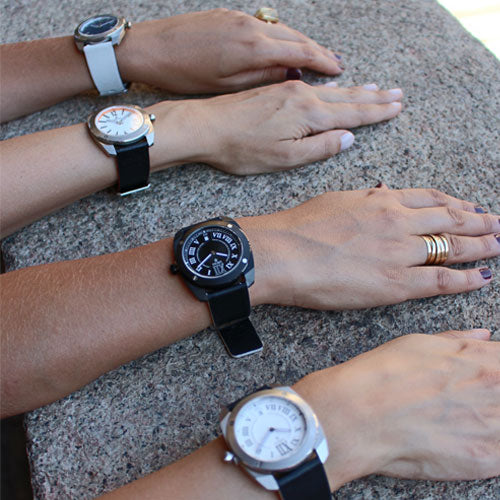QUARTZ WATCHES AND MECHANICAL WATCHES, HOW DO THEY WORK?
Most people might not be willing to admit it, but the truth is that the heavenly bodies rule human lives. From the moment they get up (when the Sun rises, in most cases) to the time they go to bed (when it sets), the human race is a slave to the interplay of light and dark. For most of our shared history, our ancestors were dependent on the astronomical movements for timekeeping. Human beings have come a long way from that, and now they have advanced, sophisticated and accurate ways of keeping time. Today, many men have sport quartz watches and mechanical watches, but what exactly are they and how do they work?
Quartz Watches
The quartz watches were introduced back in the 1970s as the latest masterpieces of high-tech gadgetry. Back then, the quartz watches came with LED displays and could cost around a lot. Today, they have either an analog movement dial or an LCD display, and they no longer cost as much as they used to in the old days.
For starters, quartz employs a cutting-edge time technology that revolutionized the entire industry of watch-making. No intricate or complicated network of gears, just a small crystal, a battery and some tiny motors – and here is a fully-functioning, precise and accurate timepiece.
The quartz movement is the marriage of science and nature. Relying on what is known as the ‘piezoelectric effect’, the quartz movement is a whole different game altogether. Powered by a battery, the quartz crystal vibrates with a sure and certain accuracy. When pressure is applied on the quartz crystal, a low electrical charge appears on its own on the crystal’s surface. This natural phenomenon works in contrast as well. The crystal of a quartz watch will shrink when electrified, and with the passing of an electrical current, it vibrates at a constant rate.
Whereas mechanical watches use a system of gears and wound spring to power and transfer their energy, a quartz powers up through a circuit board called the ‘quartz oscillator’. This energy travels through the circuit board and into the microchip, from where it charges all the other parts of the watch, including the hands. As opposed to the mechanical technology which causes the second's hand to move in a sweeping motion, the quartz movement is usually characterized by individual ticks.
The quartz technology is incredibly simple yet powerful for micro brands. The famous quartz crystal and the piezoelectric properties cause a quartz watch to generate a small volt of electricity and make the quartz inside timepiece vibrate at a natural and precise frequency. This effortless, uncomplicated mechanism is the secret behind the quartz’ once-per-second individual click.
Quartz watches make incredible and great timepieces for their superior accuracy, hassle-free self-winding mechanism and reliable craftsmanship. The advent of quartz-powered wristwatches in the 1970s largely replaced the traditional mechanical watches all around the world. The first quartz watch, introduced by the Japanese manufacturer Seiko, changed the face of the watchmaking industry forever.
Mechanical Watches
Mechanical watches are mostly purchased and used as a status symbol or appreciation of their fine craftsmanship. Modern battery-powered watches are typically more accurate than mechanical watches, but mechanical watches are still in demand today mainly for their excellent craftwork or for aesthetic reasons. These prized timepieces are a manifestation of the accumulation of 600 years of technology, expertise and refinement.
Mechanical watches are labor-intensive and time-consuming to build. A mechanical watch is powered by a mechanical technology to function as opposed to modern quartz watches which depend on an electronic mechanism. A mechanical watch works without a battery, circuitry or microchip. A mechanical watch employs a clockwork technology to keep track of time instead of the small batteries that a typical quartz watch uses. This clockwork mechanism is driven by a hand-wound mainspring. Transmitting its energy through a series of gears, a mechanical timepiece powers the balance wheel which vibrates back and forth at a constant pace. There are mainly two types of mechanical movements, the manual movement and the automatic movement.
A manual-wind watch needs to be hand-wounded by the user through the crown to wind the mainspring. This mainspring unwinds gradually and discharges the stored energy through a series of springs and gears. This force powers its mechanism and turns the watch’s hands.
Mechanical watches also require cleaning and maintenance periodically by a skilled and professional watchmaker. With the advent of Quartz watches since the 1970s, the demand for mechanical watches has shrunk considerably, and they are now mostly available as a high-end product demanded by watch collectors and watch enthusiasts.
Dwiss Design Awarded Watches
Among watch enthusiasts and hobbyists, micro brand luxury watches are becoming increasingly popular. While the first micro brand watches appeared on the scene as late as the early 2000s, with the advent and availability of internet, they have acquired a unique place in the watchmaking industry by distributing high-end designer watches directly to the consumers. Without the need for middlemen, micro brands like Dwiss empower the consumers with better prices, convenience and more choices. Whether one is looking for a classic timepiece or a daring automatic watch design, Dwiss is a designer award-winning micro brand that offers only the best in Swiss made watches and its movements. Not many micro brands can claim the kind of collection or bold aesthetics offered by Dwiss.




Share:
The Swiss Made Label
Main Watch Conglomerates